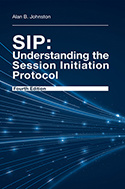Description
SIP: Understanding the Session Initiation Protocol (4th Ed.)
Author: JOHNSTON Alan B.
Language: English
Subjects for SIP: Understanding the Session Initiation Protocol :
Approximative price 132.05 €
In Print (Delivery period: 16 days).
Add to cart
Publication date: 10-2015
530 p. · Paperback
530 p. · Paperback
Description
/li>Contents
/li>Biography
/li>
Now in its fourth edition, the ground-breaking Artech House bestseller
SIP: Understanding the Session Initiation Protocol offers you the most
comprehensive and current understanding of this revolutionary protocol for
call signaling and IP Telephony.
The fourth edition incorporates changes in SIP from the last five years with new chapters on internet threats and attacks, WebRTC and SIP, and substantial updates throughout. This cutting-edge book shows how SIP provides a highly-scalable and cost-effective way to offer new and exciting telecommunication feature sets, helping practitioners design next generationù network and develop new applications and software stacks.
Other key discussions include SIP as a key component in the Internet multimedia conferencing architecture, request and response messages, devices in a typical network, types of servers, SIP headers, comparisons with existing signaling protocols including H.323, related protocols SDP (Session Description Protocol) and RTP (Real-time Transport Protocol), and the future direction of SIP.
The fourth edition incorporates changes in SIP from the last five years with new chapters on internet threats and attacks, WebRTC and SIP, and substantial updates throughout. This cutting-edge book shows how SIP provides a highly-scalable and cost-effective way to offer new and exciting telecommunication feature sets, helping practitioners design next generationù network and develop new applications and software stacks.
Other key discussions include SIP as a key component in the Internet multimedia conferencing architecture, request and response messages, devices in a typical network, types of servers, SIP headers, comparisons with existing signaling protocols including H.323, related protocols SDP (Session Description Protocol) and RTP (Real-time Transport Protocol), and the future direction of SIP.
- SIP and the Internet;Introduction to SIP
- SIP Clients and Servers
- SIP Request Messages
- SIP Response Messages
- SIP Header Fields
- Wireless, Mobility, and IMS
- Presence and Instant Messaging
- Services in SIP
- Network Address Translation
- Related Protocols
- Media Transport
- Negotiating Media Sessions
- Internet Threats and Attacks (Ch 4 from VoIPSec Book)
- SIP Security
- Media Security (Ch 10 from VoIP Sec)
- Identity (Ch 11 from VoIP Sec Book)
- VoIP/PSTN Gateway Security (Ch 12 from VoIP Sec)
- Peer to Peer SIP
- Appendix
- SIP Clients and Servers
- SIP Request Messages
- SIP Response Messages
- SIP Header Fields
- Wireless, Mobility, and IMS
- Presence and Instant Messaging
- Services in SIP
- Network Address Translation
- Related Protocols
- Media Transport
- Negotiating Media Sessions
- Internet Threats and Attacks (Ch 4 from VoIPSec Book)
- SIP Security
- Media Security (Ch 10 from VoIP Sec)
- Identity (Ch 11 from VoIP Sec Book)
- VoIP/PSTN Gateway Security (Ch 12 from VoIP Sec)
- Peer to Peer SIP
- Appendix
Alan B. Johnston is a consulting member of the technical staff at Avaya Inc. and an adjunct professor of electrical engineering at Washington University in St. Louis. He holds a Ph.D. in electrical engineering from Lehigh University and a B.E. in electrical and electronic engineering from the University of Melbourne, Australia. He is a co-author of SIP specification RFC 3261 and several other SIP-related RFCs.
© 2024 LAVOISIER S.A.S.




